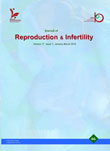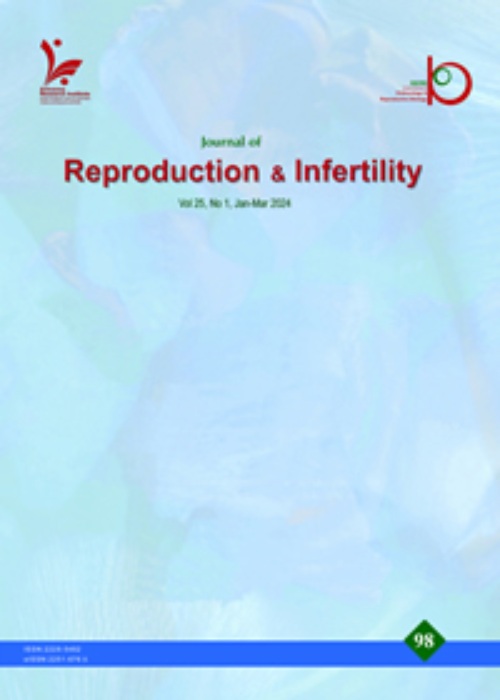فهرست مطالب

Journal of Reproduction & Infertility
Volume:17 Issue: 1, jan-mar 2016
- تاریخ انتشار: 1394/10/20
- تعداد عناوین: 11
-
-
Pages 2-9Myths are reflective of human concerns and needs during ancient times. By reviewing them, it turns out that many human problems today, have a historical background. Among the main themes of ancient mythologies, fertility and reproduction have various representations in ancient civilizations. The purpose of this paper was to review myths and common symbols of fertility and reproduction in ancient civilizations and evaluate the reasons of their continuous importance in different cultures. The data in this review study was obtained by scrutinizing the related literature. The gathered data indicated the multiplicity and variety of fertility symbols in ancient myths. Most ancient fertility symbols were inspired by the nature and some of them like earth and water were common in mythology of different civilizations. Therefore, the symbols consolidate the concept of conformity between human reproductive concerns and the nature’s necessities.Keywords: Ceremonial behavior, Culture, Fertility, Humans, Infertility, Mythology
-
Pages 10-16BackgroundUterine synechiae or Asherman''s syndrome is a condition that can cause infertility. The present experimental study was designed to establish the rabbit as an animal model for human Asherman''s syndrome using the endometrial curettage.MethodsIn an experimental study, female adult rabbits (n=18) were randomly divided into intact and ovariectomized groups. One third of caudal part of both uteri was submitted to traumatic endometrial curettage. One group was simultaneously ovariectomized. The intact rabbits were artificially induced ovulation during 10 days after surgery. One third of cranial part of both uteri was selected as the control. Synechiae occurring, luminal area/total area (LA/TA), endometrial area/total area (EA/TA), myometrial and perimetrial area/total area (MPA/TA), endometrial area/uterine wall area (EA/UWA), and myometrial and perimetrial area/uterine wall area (MPA/ UWA) ratios of both uteri in six subdivided groups (n=6) were analysed in curetted and intact control parts. On days 15, 30 and 45 following surgery by two-way ANOVA and LSD test (p<0.05).ResultsHistopathologic findings showed significant epithelial damage together with significant inflammatory reaction in the intact curettage group. The LA/TA ratios of the intact curettage group on days 15 and 45 were more than the intact control group on day 15. The EA/TA ratio of the intact curettage group on day 30 was less than the intact control group on day 30.ConclusionUterine fibrosis was observed in intact curettage group, and this modified animal model showed a pathogenesis condition similar to intrauterine adhesions observed in human.Keywords: Animal model, Asherman's syndrome, Rabbit, Uterine synechia
-
Pages 17-25BackgroundPituitary and gonadal dysfunctions resulting from increased adiposity leading to disturbances of sexual and reproductive functions have been reported in males with metabolic syndrome (MS) and type 2 diabetes mellitus (DM2). The aim of this study was to evaluate sexual dysfunction, leptin, and reproductive hormones in Nigerian males with MS and DM2.MethodsParticipants were 104 men (34 males with DM2, 17 men with MS and 53 men with normal body mass index (18.5-24.9 Kg/m2) without MS (controls)). The International Diabetes Federation (2005) criteria were used for MS diagnosis. Reproductive history, anthropometry, blood pressure (BP) and 10 ml fasting blood samples were obtained by standard methods. Fasting plasma glucose, total cholesterol, triglycerides and high density lipoprotein cholesterol were determined by enzymatic methods while low density lipoprotein cholesterol was calculated. Leptin, follicle stimulating hormone (FSH), luteinising hormone (LH), prolactin, testosterone and oestrogen were determined by enzyme immunoassay (leptin by Diagnostic Automation, Inc.; others by Immunometrics (UK) Ltd.) while oestrogen-testosterone ratio was calculated. Data analyzed using ANOVA, Chi square and multiple regression were statistically significant at p<0.05.ResultsTestosterone was significantly lower in MS than controls while oestradiol and ETR were significantly higher in MS compared with controls and DM2 group (p<0.05). ETR significantly predicted testosterone in all groups (p<0.05). Significantly lower libido was observed in men in MS than controls and DM2 groups (p<0.05).ConclusionSexual and reproductive dysfunction may be related to increased conversion of testosterone to oestrogen in increased adipose mass in men with metabolic syndrome and type 2 diabetes mellitus.Keywords: Cardiovascular disease_Leptin_Lipids_Metabolic syndrome_Pituitary hormones_Sex hormone_Sexual dysfunction_Type 2 diabetes mellitus
-
Pages 26-33BackgroundSexual dysfunctions are one of the most fundamental difficulties for infertile women, which can be as the cause of infertility. This study investigated the prevalence of this disorder and associated factors in order to improve infertility treatment process and the quality of life of women referring to infertility center.MethodsA cross sectional study was performed on 236 women who referred to Fatima Zahra infertility center of Babol, Iran. Data collection tool was a questionnaire contained two parts; demographic characteristics and infertility information. Also, data for sexual dysfunction was obtained through diagnostic interview based on the international classification DSM-IV. For data analysis, logistic and linear regression analysis were used. The p<0.05 was considered significant.ResultsMost of women (84.9%) suffered from primary infertility and the mean duration of infertility was 60.2±8.4 months. The prevalence of sexual dysfunction was 55.5% (n=131); including dyspareunia in 28% (n=66), impaired sexual desire and lack of orgasm in 26.3% (n=62 patients), vaginismus in 15.2% (n=36) and lack of sexual stimulation in 13.6% (n=32). Binary logistic regression analysis showed that age, sexual satisfaction and history of mental illness had a significant effect on the probability of experiencing the sexual dysfunction.ConclusionThere is a high prevalence of sexual dysfunction among infertile women. Considering the interaction between sexual dysfunction and infertility, professional health care centers should be sensitive to this effect. Also, more attention must be paid on marital relationships, economic and social situation and infertility characteristics in order to prevent sexual dysfunction development through early screening and psychological interference.Keywords: Infertility, Sexual dysfunction, Women
-
Pages 34-38BackgroundThere is a growing concern about the high prevalence of vitamin D deficiency and its relationship with variety of diseases worldwide. The objective of this study was to determine the prevalence of vitamin D deficiency and its relationship with pregnancy adverse effects in Yazd.MethodsThis was a cross sectional study conducted among 200 nulliparous women from October 2013 to April 2014. Data containing socio-demographic and personal details, vitamin D level, pregnancy complications and growth situation of newborns were collected and analyzed using Mann-Whitney, Kruskal-Wallis and Pearson’s correlation coefficient by SPSS. p<0.05 was considered statistically significant.ResultsThe mean serum 1, 25 (OH)2D3 concentration was 20.3±10.8 µg/l. Totally, 78% of the women had less than sufficient levels. Mean of vitamin D was significantly higher in natural or elective cesarean in comparison with abortion and emergency cesarean (p=0.040). Risk of abortion was 3.1(1.39-6.8) and higher in severely deficient group in comparison to women with vitamin D deficiency (p=0.017) and mean of vitamin D group was significantly lower in women who had oligohydramnios or polyhydramnios complication (p=0.045).ConclusionThe study findings revealed that vitamin D deficiency is prevalent in pregnant women and it is significantly associated with elevated risk for abortion, and oligohydramnios or polyhydramnios. Probably, a targeted screening strategy can be suggested to detect and treat women at high risk of vitamin D deficiency in early pregnancy as a simple way to reduce the risk of these adverse pregnancy outcomes in Yazd.Keywords: Pregnancy complications_Vitamin D deficiency_Women.
-
Pages 39-46BackgroundPerineal pain is a major morbidity in the first few days after delivery. This study aimed to investigate the effect of dry cupping therapy and acupressure at BL23 point on the intensity of postpartum perineal pain based on the short-form of McGill pain questionnaire (SMPQ).MethodsThe present clinical trial was conducted on 150 subjects in 3 groups of 50 cases. After at least 4-8 hr of delivery, cupping therapy was performed for 15-20 min up to 3 times a week (once a day) and acupressure was performed for 15-20 min based on clockwise model. The short-form of McGill pain questionnaire was completed both before and after the intervention. The SPSS statistical software was used to analyze the data using repeated measures ANOVA. Besides, p<0.05 was considered statistically significant.ResultsIn the cupping therapy group, mean of the perineal pain intensity reduced from 37.5±6.8 before the intervention to 11.1±6.1, 6.9±4.7, and 3.8±3.6 immediately, 24 hr, and 2 weeks after the intervention, respectively. The results of study showed that the differences between the intervention and control groups were statistically significant (p<0.01). Mean difference of the perineal pain intensity in the acupressure group reached from 35.6±8.1 before the intervention to 10.4±5.5 two weeks after the intervention, so the variation between intervention and control groups was statistically significant.ConclusionThe study findings showed that cupping therapy and acupressure reduced perineal pain. Therefore, they may be considered as effective treatments for reducing pain intensity of allowing delivery.Keywords: Acupressure, BL23 point, Dry cupping, Perineal pain, Postpartum
-
Pages 47-55BackgroundSexual function is affected by personal and interpersonal factors, familial and social traditions, culture, religion, menopause, and aging. So, ethnicity is a determining factor in sexual function. The present study aimed to investigate the prevalence of sexual dysfunction and attitudes towards sexuality in postmenopausal women among three different ethnic groups in Iran.MethodsThis cross-sectional study was conducted on 746 postmenopausal women between 50 and 89 years who referred to Honoree clinic, Jahrom in 2013. Among the study participants, 42.4% were Arab, 33.5% were Persian, and 24.1% were Lor. Data were collected about women’s socio-demographic characteristics, attitudes regarding sexuality and sexual function. The descriptive statistics were used for demographic variables. Moreover, ANOVA, post hoc (LSD) was used. Besides, p<0.05 was considered statistically significant.ResultsThe participants’ mean age was 60.10±6.89 years and the total mean score of Female Sexual Function Index (FSFI) was 19.31±8.5. In addition, 81.5% of the women had sexual dysfunction (FSFI <26.55) and only 147 women (18.5%) had normal sexual function (FSFI >26.55). Sexual dysfunction was 75.3% in Arabs, 83.2% in Persians, and 86.1% in Lors. Besides, the most prevalent sexual dysfunction was dyspareunia in Arabs and arousal disorder in Persians and Lors.ConclusionThe results of this study showed that sexual dysfunction is considerable among postmenopausal women. The most prevalent sexual dysfunction was dyspareunia in Arabs and arousal disorder in Persians and Lors.Keywords: Ethnic groups, Menopause, Sexual dysfunction, Women's attitude.
-
Pages 56-60BackgroundUsing appropriate coping strategies has a positive influence on moderating mental pressures caused by infertility and the stress during treatment. Using these strategies needs personal skills and they could be influenced by individual’s inner psychological and environmental factors. The aim of this study was to assess the relationship between the attitude toward infertility and coping strategies considering the couple’s social and financial situation.MethodsThis was a cross sectional study conducted on 133 volunteered couples undergoing assisted reproductive treatment. Coping strategies and the attitude toward infertility were assessed using a self-report questionnaire. Higher scores of attitude indicated positive attitudes. Data was analyzed using paired-samples t test and multiple regression model.ResultsIndependent from demographic information and causes of infertility, using self-blame and self-focused rumination coping strategies were negatively related to attitude toward infertility in both men and women (p<0.05). Also, using self-blame coping strategy had a positive correlation with female infertility and negative correlation with male infertility.ConclusionRegardless of the economic and social conditions, in infertile couples, downward trend in attitude toward infertility is mostly associated with the use of maladaptive coping strategies.Keywords: Assisted reproductive treatments, Attitude, Coping strategies, Infertility
-
Pages 61-63BackgroundThe interaction between HIV and Trichomonas vaginalis infection has been widely studied in most developed countries but with scanty information in subSaharan Africa. While many of these studies have examined the prevalence of T. vaginalis infection in HIV positive individuals, no study in Nigeria has shown the effect of T. vaginalis on HIV transmission. Therefore, the study aimed to determine the occurrence of HIV in T. vaginalis infected women.MethodsA descriptive study was conducted among women attending STI clinic at the General Hospital, Badagry, Lagos, Nigeria. A total number of 201 (T. vaginalis infected) women were screened for HIV using rapid diagnostic test kits.ResultsThe frequency of HIV in T. vaginalis infected women was 35.8%.ConclusionThe study showed that T. vaginalis infection in women may be a high risk factor of HIV infection.Keywords: HIV transmission, Nigeria, Severity, Trichomonas vaginalis


